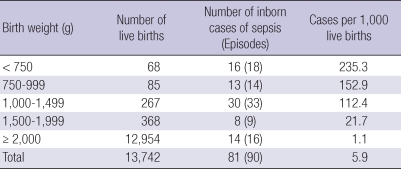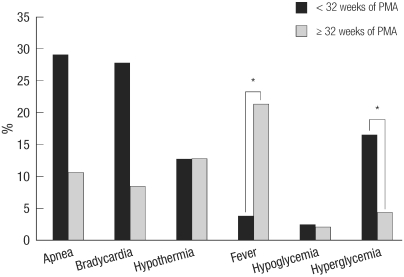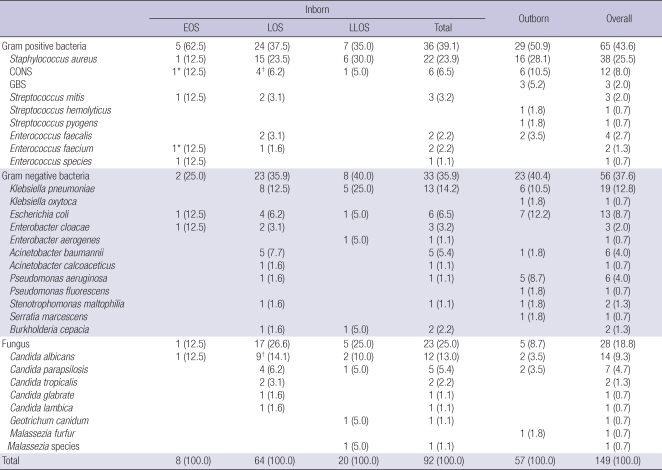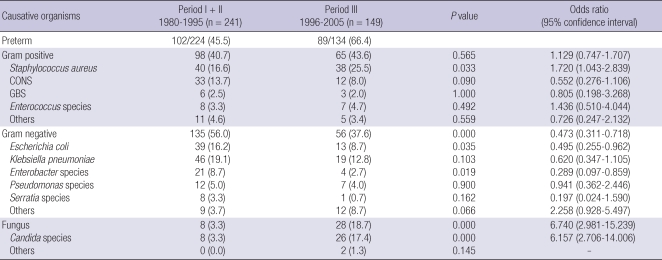Abstract
There were many reports of longitudinal changes in the causative organisms of neonatal sepsis in Western countries but few in Asia. We aimed to study longitudinal trends in the epidemiology of neonatal sepsis at Seoul National University Children's Hospital (SNUCH), a tertiary center in Korea, and compared the results to previous studies of Western countries. The medical records of all of the neonates who were hospitalized at SNUCH from 1996 to 2005 with positive blood cultures were reviewed. We also compared the findings to previous 16-yr (1980-1995). One hundred and forty-nine organisms were identified in 147 episodes from 134 infants. In comparison with the previous 16-yr studies, there was a decrease in the number of Escherichia coli infections (16.2% vs 8.7%: odds ratio [OR] 0.495; 95% confidence interval [CI], 0.255-0.962; P = 0.035), but an increase in Staphylococcus aureus (16.6% vs 25.5%: OR 1.720; 95% CI, 1.043-2.839; P = 0.033) and fungal infections (3.3% vs 18.7%: OR 6.740; 95% CI, 2.981-15.239; P < 0.001), predominantly caused by Candida species. In conclusion, the incidence of sepsis caused by E. coli decreases, but S. aureus and fungal sepsis increases significantly. Compared with Western studies, the incidence of sepsis caused by S. aureus and fungus has remarkably increased.
Keywords: Sepsis, Organism, Epidemiology
INTRODUCTION
Despite advances in perinatal care, neonatal sepsis is still a significant cause of morbidity and mortality in neonates. Over time, the causative organisms of neonatal sepsis has changed; thus, an institutional survey for infectious diseases is essential for the prevention and treatment of neonatal invasive infections. This is particularly important because regional differences in the specific causative organisms of neonatal sepsis have been previously reported (1-4). In the United States and European countries, the incidence of sepsis caused by group B Streptococcus (GBS) and Escherichia coli was decreased but the incidence of sepsis caused by coagulase negative Staphylococcus (CONS), Staphylococcus aureus and Candida species was increased (1, 4, 5-7). Longitudinal changes in the incidence and etiology of neonatal sepsis has been well studied in North America and Europe, but not in many Asian countries.
The neonatal intensive care unit (NICU) at Seoul National University Children's Hospital (SNUCH), a tertiary NICU with 300-600 annual admissions, has run ongoing surveillance for neonatal sepsis since 1980. During that time, the NICU has gradually expanded, and severity of the patients increased.
In this report, we studied trends in the causative organisms of neonatal sepsis during 10 yr (1996-2005), and compared these trends with the previous 16-yr (1980-1995). We aimed to investigate a longitudinal change the causative organisms of neonatal sepsis in a tertiary center in Korea, and compared the results to previous studies of Western countries.
MATERIALS AND METHODS
Study population and microbiological tests
SNUCH has a tertiary NICU and receives both inborn patients from high-risk pregnancies and patients transported nationwide. All of the patients with blood cultures positive for any microorganism were identified from a retrospective review of the computerized records and logbooks of the Clinical Microbiology Laboratory. The medical records of all of the neonates and infants who were inpatients in the NICU at SNUCH from 1996 to 2005 (Period III) with positive blood cultures were reviewed. In addition, the medical records of all of the neonates who were less than 30 days of age with positive blood cultures and who were hospitalized outside of the NICU at SNUCH during the same period were reviewed. The data were compared with previous 2-period (Period I: 1980-1985, Period II: 1986-1995).
Microorganism identification was performed with VITEK GPI card (bioMerieux, Hazelwood, MO, USA). The antibiotic susceptibilities of the microorganisms were determined using the National Committee for Clinical Laboratory Standards (NCCLS) disk-diffusion method.
Definition
Fever (hyperthermia) and hypothermia were defined as having a core temperature of > 38.0℃ and < 36.5℃, respectively. Apnea and bradycardia were included as clinical sign of sepsis only when the episodes were newly developed or the frequency and duration of the episodes increased. Hypoglycemia and hyperglycemia were defined as having a blood glucose of < 40 mg/dL and > 140 mg/dL, respectively (1).
The criteria for the diagnosis of neonatal sepsis required isolation of the microorganism from a blood culture and at least one clinical sign or symptom. For instance, in cases that had microorganisms common in skin contamination (e.g., diphtheroids, Bacillus species, Propionibacterium species or micrococci), a definition of sepsis was defined by documentation of a sign or symptom such as a fever, hypothermia, apnea, bradycardia, hypoglycemia and hyperglycemia along with either pathogen isolation from two blood cultures drawn on separate occasions or at least one peripheral blood culture from a patient with a central venous catheter (8). Sepsis of CONS was reviewed using criteria for the diagnosis of CONS defined by Bizzarro et al. (1). Sepsis was classified as early onset (EOS, ≤ 4 days of life), late onset (LOS, 5-30 days) and late, late onset (LLOS, > 30 days) (1).
A sepsis-related death was defined when death occurred within 7 days of a positive blood culture or when the clinical signs and symptoms of sepsis manifested (1). Sepsis-related mortality was calculated with the numerator representing the number of episodes of sepsis.
Statistics
The results were analyzed using SPSS version 12.0 (SPSS, Inc., Chicago, IL, USA). A Student's t-test was used for comparison of the continuous variables. Pearson's chi-square test or Fisher's exact test (both two-sided) were used for comparison of the categorical variables when necessary. A value of P < 0.05 was considered to be statistically significant.
Ethics statement
The study protocol was approved by the institutional review boards of the Seoul National University Hospital (IRB No. H-0902-033-272). Informed consent was waived by the IRB.
RESULTS
During 10 yr (Period III; 1996-2005) of this study, there was a total of 13,742 live births and a total of 1,479 outborn neonates in SNUCH. The numbers of live births declined from a total of 1,888 in 1996 to a total of 1,001 in 2005. The inborn admission rate of extremely low birth weight (ELBW) infants (birth weight < 1,000 g) was 11.1 per 1,000 live births and the admission rate of infants weighing 1,000 g to 1,500 g was 19.4 per 1,000 live births.
A total of 502 blood cultures were positive from 310 patients. After a review of all 310 patients, 147 episodes were defined as neonatal sepsis from 134 patients. One hundred and twenty-six episodes (85.7%) occurred in patients who were in admitted to the NICU and 21 episodes occurred in patients who were admitted to the pediatric intensive care unit or pediatric wards. The percentage of male from all of the populations was 57.1%, the mean gestational age was 32 ± 5 weeks and the mean birth weight was 1,835 ± 1,113 g. The total sepsis rate of inborn neonates was 5.9 per 1,000 live births and infants with a lower birthweight had higher sepsis rates (Table 1). There were 12 sepsis-related mortality cases and the overall mortality rate was 9.0% (12/134).
Table 1.
Sepsis rates for inborn infants by birth weight (1996-2005)
Apnea (19.7%) and fever (19.7%) were the most common symptoms of sepsis. There were significant differences in the symptoms of sepsis, based on the gestational age. Apnea and bradycardia were common in the total population, whereas fever was common only in the ≥ 32 weeks postmenstrual age (PMA) group, and hyperglycemia was more frequent in the < 32 weeks PMA group (Fig. 1).
Fig. 1.
Comparison of the clinical symptoms of neonatal sepsis between early ages (< 32 weeks of PMA) and late ages (≥ 32 weeks of PMA). *P < 0.05. PMA, postmenstrual age.
Of the 147 episodes of neonatal sepsis, 90 (61.1%) episodes were in the inborn neonates and 57 (38.9%) episodes were in the outborn cases (Table 2). Of the 90 episodes in the inborn neonates, 7 (7.8%) were EOS, 63 (70.0%) were LOS and 20 (22.2%) were LLOS (Table 2). During the study period, 149 microorganisms were isolated from the 147 episodes of sepsis. Gram-positive bacteria accounted for 65 (43.6%), Gram-negative bacteria for 56 (37.6%), and fungus for 28 (18.8%) episodes. The common microorganisms found were S. aureus (n = 38, 25.5%), Candida species (n = 25, 16.8%), Klebsiella pneumoniae (n = 19, 13.4%), E. coli (n = 13, 8.7%) and CONS (n = 12, 8.1%) (Table 2). There were two episodes of mixed infections. One mixed infection was the EOS of CONS with Enterococcus faecium and the other mixed infection was the LOS of CONS with Candidia albicans.
Table 2.
Causative organisms of neonatal sepsis at SNUCH (1996-2005)
Data presented as number (%). *Mixed infection: CONS + Enterococcus faecium; †Mixed infection: CONS + Candida albicans. SNUCH, Seoul National University Children's Hospital; EOS, early onset sepsis; LOS, late onset sepsis; LLOS, late, late onset sepsis; CONS, coagulase-negative Staphylococcus; GBS, Group B Streptococcus.
EOS in inborn neonates included 8 cases and had no GBS cases and no predominant microorganisms. The most common microorganism of 63 LOS cases was Candida species (n = 17, 26.6%) followed by S. aureus (n = 15, 23.4%) and K. pneumoniae (n = 8, 12.5%). There were 20 episodes of LLOS, and the predominant microorganisms were S. aureus (n = 6, 30.0%) and K. pneumoniae (n = 5, 25.0%). There were 57 episodes of neonatal sepsis in outborn neonates and the most common causative organism was S. aureus (n = 16, 28.1%). Most of the S. aureus isolates (36/38) were methicillin-resistant and all of the CONS isolates were methicillin-resistant. There were two episodes of mixed infections.
Fig. 2 shows the overall trend in sepsis cases over 26 yr in SNUCH. During the 26 yr, S. aureus was the most common causative organisms of neonatal sepsis. Compared to the decade just before the study period, the incidence of sepsis caused by S. aureus (Period I + II vs Period III: odds ratio [OR] 1.720; 95% confidence interval [CI], 1.043-2.839; P = 0.033) and fungus (Period I + II vs Period III: OR 6.740; 95% CI, 2.981-15.239; P < 0.001) were increased, but the incidence of sepsis caused by E. coli (Period I + II vs Period III: OR 0.495; 95% CI, 0.255-0.962; P = 0.035) was decreased (Table 3).
Fig. 2.
Comparison of the percentage of the cause of neonatal sepsis; 1980-2005. Data presented as percent (%). CONS, coagulase-negative Staphylococcus; GBS, group-B Streptococcus. *P < 0.05 vs Period I+II and Period III; †P < 0.05 vs Period I and Period II; ‡P < 0.05 vs Period I and Period III; §P < 0.05 vs Period II and Period III.
Table 3.
Comparison of ratio of causative organisms between each period
Data presented as number (%). CONS, coagulase-negative Staphylococcus; GBS, group-B Streptococcus.
DISCUSSION
The reported incidence of neonatal sepsis varies from 2.8 to 8.1 cases per 1,000 live births (9-11). The inborn neonatal sepsis rate for a recent 10-yr period at our center was 5.9 cases per 1,000 live births, and this result is similar to of the Yale New Haven Hospital (7.1 cases per 1,000 live births) (1).
For the last 10 yr, most of the cases of inborn neonatal sepsis were LOS. There were only 7 (8.0%) cases of EOS out of 88 inborn neonatal sepsis cases at SNUCH. In Korea, the estimated incidence of GBS infection in newborns has been much lower than in other countries (12), due to the low prevalence rate of GBS colonization in pregnant women (13, 14). In fact, there were only 3 GBS sepsis cases in our study and all of these cases were outborn and LOS. This result might contribute to Korea's lower incidence of EOS compared to other countries (1, 15).
Apnea, bradycardia, hyperglycemia and fever were common symptoms in neonates with sepsis. Apnea, bradycardia and hyperglycemia were more common in PMA < 32 weeks neonates. In contrast, a fever was more common symptom in PMA ≥ 32 weeks neonates. These results indicate that very preterm infants (< 32 weeks of PMA) with sepsis tend to show non-specific symptoms rather than a typical infection sign such as a fever. Therefore, careful evaluation of clinical status is important for the early detection of infectious disease in preterm infants.
The common causative organisms of neonatal sepsis were S. aureus, Candida species, K. pneumoniae, E. coli and CONS. Compared to other studies from Korea, the frequency of CONS and GBS was lower, but the frequency of Klebsiella species and Candida species was higher (15-17). These results may be due to the differences of characteristics of patients, policy of antibiotic uses and normal flora. Furthermore, our reports revealed that most S. aureus and CONS isolates were methicillin-resistant. This result reflects the observation that S. aureus and CONS colonization of infants hospitalized in the NICU was very prevalent. A higher rate of methicillin-resistant Gram-positive organism colonization in NICU infants has recently emerged worldwide, and is the major cause of neonatal blood-stream infections. A chemotherapeutic strategy for neonatal sepsis should be re-evaluated and the appropriate use of antibiotics must be re-emphasized. Prophylactic use of antibiotics and broad-spectrum antibiotics use should be minimized (18).
In comparison with previous data from our institution, the number of cases of E. coli was reduced, but the number of cases of S. aureus and fungal infections were increased (Fig. 2, Table 3) (19). This decline in E. coli cases and the increase in fungal cases is similar to other reports (1, 4-7, 20, 21). Previous studies have shown that the rising incidence of fungal infections is related to a higher survival rate of VLBW infants and an increase in the incidence of prolonged use of broad-spectrum antibiotics (22-25). Over the last 10 yr, the Korean birth rate has decreased but the birth rate of preterm infants has increased. In SNUCH, the total number of preterm infants has increased and the infant survival rate has improved dramatically over the last 10 yr. A higher incidence of catheter uses, a longer duration of TPN uses and a longer duration of antibiotics uses were associated with an increased survival rate of the VLBW infants especially the ELBW infants. Several studies have revealed that low birth weight and prematurity are significant risk factors for neonatal sepsis (26, 27). In addition, our studies have shown that the inborn sepsis rate in infants with a birth weight < 1,500 g (152.4 cases per 1,000 live births) was 84.7 times higher than that in infants with a birth weight ≥ 1,500 g (1.8 cases per l,000 live births). An increased fungal sepsis rate was associated with an increased survival of ELBW infants, resulting in a longer hospital stay. We also experienced an increased fungal sepsis rate over the study period. We recently introduced 'fluconazole prophylaxis' in the ELBW infants after the study period (28). Following this introduction, the fungal sepsis rate found in our institution dramatically decreased (data not shown). However, this result needs careful interpretation because it might be due to a lowering of the overall sensitivity of microbiological culture for the detection of fungi in the blood, urine or cerebrospinal fluid (29).
Compared to studies from Finland and the United States, the frequency of GBS, CONS, and E. coli was lower, but the frequency of Klebsiella species, Pseudomonas species, and Candida species was higher (1, 4). These findings again emphasize the regional difference of sepsis-causing organisms and the importance of the establishment of a suitable strategy to diagnose neonatal sepsis by region. The longitudinal trends of decreased incidence of E. coli sepsis were comparable with Western studies. But our study showed increased incidence of sepsis caused by S. aureus and strikingly increased incidence of fungal sepsis, predominantly caused by Candida species (1, 4, 30).
In conclusion, the incidence of sepsis caused by E. coli decreases, but S. aureus and fungal sepsis increased significantly. In contrast to Western studies, our study showed a higher rate of sepsis caused by S. aureus and Klebsiella species, and a lower rate of sepsis caused by CONS and GBS (1, 4). In addition, the incidence of sepsis caused by S. aureus and fungus has remarkably increased (1, 4, 30).
AUTHOR SUMMARY
Trends in Epidemiology of Neonatal Sepsis in a Tertiary Center in Korea: A 26-Year Longitudinal Analysis, 1980-2005
Gyu Hong Shim, Sang Duk Kim, Han Suk Kim, Eun Sun Kim, Hyun-Ju Lee, Jin-A Lee, Chang Won Choi, Ee-Kyung Kim, Eun Hwa Choi, Beyong Il Kim, Hoan Jong Lee, and Jung Hwan Choi
We aimed to study longitudinal trends in the epidemiology of neonatal sepsis a tertiary center in Korea. The medical records of all of the neonates who were hospitalized at Seoul National University Children's Hospital from 1996 to 2005 with positive blood cultures were reviewed. We also compared the findings to previous 16-yr (1980-1995). One hundred and forty-nine organisms were identified from 134 infants. In comparison with the previous 16-yr studies, there was a decrease in the number of Escherichia coli infections, but an increase in Staphylococcus aureus and fungal infections. In conclusion, the incidence of sepsis caused by E. coli decreases, but S. aureus and fungal sepsis increases significantly. Compared with Western studies, the incidence of sepsis caused by S. aureus and fungus has remarkably increased.
References
- 1.Bizzarro MJ, Raskind C, Baltimore RS, Gallagher PG. Seventy-five years of neonatal sepsis at Yale: 1928-2003. Pediatrics. 2005;116:595–602. doi: 10.1542/peds.2005-0552. [DOI] [PubMed] [Google Scholar]
- 2.Stoll BJ, Hansen N, Fanaroff AA, Wright LL, Carlo WA, Ehrenkranz RA, Lemons JA, Donovan EF, Stark AR, Tyson JE, Oh W, Bauer CR, Korones SB, Shankaran S, Laptook AR, Stevenson DK, Papile LA, Poole WK. Late-onset sepsis in very low birth weight neonates: the experience of the NICHD Neonatal Research Network. Pediatrics. 2002;110:285–291. doi: 10.1542/peds.110.2.285. [DOI] [PubMed] [Google Scholar]
- 3.Vesikari T, Janas M, Grönroos P, Tuppurainen N, Renlund M, Kero P, Koivisto M, Kunnas M, Heinonen K, Nyman R, Pettay O, Osterlund K. Neonatal septicaemia. Arch Dis Child. 1985;60:542–546. doi: 10.1136/adc.60.6.542. [DOI] [PMC free article] [PubMed] [Google Scholar]
- 4.Rønnestad A, Abrahamsen TG, Gaustad P, Finne PH. Blood culture isolates during 6 years in a tertiary neonatal intensive care unit. Scand J Infect Dis. 1998;30:245–251. doi: 10.1080/00365549850160873. [DOI] [PubMed] [Google Scholar]
- 5.Butler KM, Baker CJ. Candida: an increasingly important pathogen in the nursery. Pediatr Clin North Am. 1988;35:543–563. doi: 10.1016/s0031-3955(16)36471-9. [DOI] [PubMed] [Google Scholar]
- 6.Rangel-Frausto MS, Wiblin T, Blumberg HM, Saiman L, Patterson J, Rinaldi M, Pfaller M, Edwards JE, Jr, Jarvis W, Dawson J, Wenzel RP. National epidemiology of mycoses survey (NEMIS): variations in rates of bloodstream infections due to Candida species in seven surgical intensive care units and six neonatal intensive care units. Clin Infect Dis. 1999;29:253–258. doi: 10.1086/520194. [DOI] [PubMed] [Google Scholar]
- 7.Fridkin SK, Kaufman D, Edwards JR, Shetty S, Horan T. Changing incidence of Candida bloodstream infections among NICU patients in the United States: 1995-2004. Pediatrics. 2006;117:1680–1687. doi: 10.1542/peds.2005-1996. [DOI] [PubMed] [Google Scholar]
- 8.Garner JS, Jarvis WR, Emori TG, Horan TC, Hughes JM. CDC definitions for nosocomial infections, 1988. Am J Infect Control. 1988;16:128–140. doi: 10.1016/0196-6553(88)90053-3. [DOI] [PubMed] [Google Scholar]
- 9.Tessin I, Trollfors B, Thiringer K. Incidence and etiology of neonatal septicaemia and meningitis in western Sweden 1975-1986. Acta Paediatr Scand. 1990;79:1023–1030. doi: 10.1111/j.1651-2227.1990.tb11378.x. [DOI] [PubMed] [Google Scholar]
- 10.Hervás JA, Alomar A, Salvá F, Reina J, Benedí VJ. Neonatal sepsis and meningitis in Mallorca, Spain, 1977-1991. Clin Infect Dis. 1993;16:719–724. doi: 10.1093/clind/16.5.719. [DOI] [PubMed] [Google Scholar]
- 11.Persson E, Trollfors B, Brandberg LL, Tessin I. Septicaemia and meningitis in neonates and during early infancy in the Göteborg area of Sweden. Acta Paediatr. 2002;91:1087–1092. doi: 10.1080/080352502760311593. [DOI] [PubMed] [Google Scholar]
- 12.Kim KA, Shin SM, Choi JH. A nationwide survey on the causative organisms of neonatal sepsis in Korea. J Korean Pediatr Soc. 2002;45:55–63. [Google Scholar]
- 13.Kim TH, Park SE, Kim KH. A study of group B streptococcal infection in pregnant women, by LIM broth media. Korean J Pediatr. 2004;47:1072–1075. [Google Scholar]
- 14.Choi KU, Koh SK, Lee JY, Park JH, Hwang SO, Lee BI, Lee WY. Clinical significance of group B streptococcal infection in pregnant women. Korean J Obstet Gynecol. 2002;45:811–815. [Google Scholar]
- 15.Park HW, Lim G, Koo SE, Lee BS, Kim KS, Pi SY, Kim AR. Causative agents and antimicrobial sensitivity of neonatal sepsis: Ten-year experience in one neonatal intensive care unit. J Korean Soc Neonatol. 2009;16:172–181. [Google Scholar]
- 16.Chun P, Kong SG, Byun SY, Park SE, Lee HD. Analysis of neonatal sepsis in one neonatal intensive care unit for 6 years. Korean J Pediatr. 2010;53:495–502. [Google Scholar]
- 17.Sung JS, Kim DY, Kim SH, Byun HS, Hwang TJ, Choi YY. Analysis of causative microorganisms and choice of antibiotics according to the onset of neonatal sepsis. Korean J Pediatr. 2006;49:623–629. [Google Scholar]
- 18.Hwang JH, Choi CW, Chang YS, Choe YH, Park WS, Shin SM, Lee M, Lee SI. The efficacy of clinical strategies to reduce nosocomial sepsis in extremely low birth weight infants. J Korean Med Sci. 2005;20:177–181. doi: 10.3346/jkms.2005.20.2.177. [DOI] [PMC free article] [PubMed] [Google Scholar]
- 19.Kim BI, Chung HL, Kim YD, Park WS, Shin SM, Lee HJ, Choi JH, Yun CK. Clinical observations on neonatal sepsis. J Korean Pediatr Soc. 1987;30:130–138. [Google Scholar]
- 20.Gluck L, Wood HF, Fousek MD. Septicemia of the newborn. Pediatr Clin North Am. 1966;13:1131–1148. doi: 10.1016/s0031-3955(16)31911-3. [DOI] [PubMed] [Google Scholar]
- 21.Gladstone IM, Ehrenkranz RA, Edberg SC, Baltimore RS. A ten-year review of neonatal sepsis and comparison with the previous fifty-year experience. Pediatr Infect Dis J. 1990;9:819–825. doi: 10.1097/00006454-199011000-00009. [DOI] [PubMed] [Google Scholar]
- 22.Huang YC, Li CC, Lin TY, Lien RI, Chou YH, Wu JL, Hsueh C. Association of fungal colonization and invasive disease in very low birth weight infants. Pediatr Infect Dis J. 1998;17:819–822. doi: 10.1097/00006454-199809000-00014. [DOI] [PubMed] [Google Scholar]
- 23.Saiman L, Ludington E, Dawson JD, Saiman L, Ludington E, Dawson JD, Patterson JE, Rangel-Frausto S, Wiblin RT, Blumberg HM, Pfaller M, Rinaldi M, Edwards JE, Wenzel RP, Jarvis W National Epidemiology of Mycoses Study Group. Risk factors for Candida species colonization of neonatal intensive care unit patients. Pediatr Infect Dis J. 2001;20:1119–1124. doi: 10.1097/00006454-200112000-00005. [DOI] [PubMed] [Google Scholar]
- 24.El-Masry FA, Neal TJ, Subhedar NV. Risk factors for invasive fungal infection in neonates. Acta Paediatr. 2002;91:198–202. doi: 10.1080/080352502317285216. [DOI] [PubMed] [Google Scholar]
- 25.Saiman L, Ludington E, Pfaller M, Rangel-Frausto S, Wiblin RT, Dawson J, Blumberg HM, Patterson JE, Rinaldi M, Edwards JE, Wenzel RP, Jarvis W. Risk factors for candidemia in neonatal intensive care unit patients. The National Epidemiology of Mycosis Survey study group. Pediatr Infect Dis J. 2000;19:319–324. doi: 10.1097/00006454-200004000-00011. [DOI] [PubMed] [Google Scholar]
- 26.Stoll BJ, Hansen N. Infections in VLBW infants: studies from the NICHD Neonatal Research Network. Semin Perinatol. 2003;27:293–301. doi: 10.1016/s0146-0005(03)00046-6. [DOI] [PubMed] [Google Scholar]
- 27.Fanaroff AA, Korones SB, Wright LL, Verter J, Poland RL, Bauer CR, Tyson JE, Philips JB, 3rd, Edwards W, Lucey JF, Catz CS, Shankaran S, Oh W For The National Institute of Child Health and Human Development Neonatal Research Network. Incidence, presenting features, risk factors and significance of late onset septicemia in very low birth weight infants. Pediatr Infect Dis J. 1998;17:593–598. doi: 10.1097/00006454-199807000-00004. [DOI] [PubMed] [Google Scholar]
- 28.Manzoni P, Stolfi I, Pugni L, Decembrino L, Magnani C, Vetrano G, Tridapalli E, Corona G, Giovannozzi C, Farina D, Arisio R, Merletti F, Maule M, Mosca F, Pedicino R, Stronati M, Mostert M, Gomirato G, Italian Task Italian Task Force for the Study and Prevention of Neonatal Fungal Infections; Italian Society of Neonatology. A multicenter, randomized trial of prophylactic fluconazole in preterm neonates. N Engl J Med. 2007;356:2483–2495. doi: 10.1056/NEJMoa065733. [DOI] [PubMed] [Google Scholar]
- 29.Brecht M, Clerihew L, McGuire W. Prevention and treatment of invasive fungal infection in very low birthweight infants. Arch Dis Child Fetal Neonatal Ed. 2009;94:F65–F69. doi: 10.1136/adc.2007.133769. [DOI] [PubMed] [Google Scholar]
- 30.Van den Hoogen A, Gerards LJ, Verboon-Maciolek MA, Fleer A, Krediet TG. Long-term trends in the epidemiology of neonatal sepsis and antibiotic susceptibility of causative agents. Neonatology. 2010;97:22–28. doi: 10.1159/000226604. [DOI] [PubMed] [Google Scholar]







